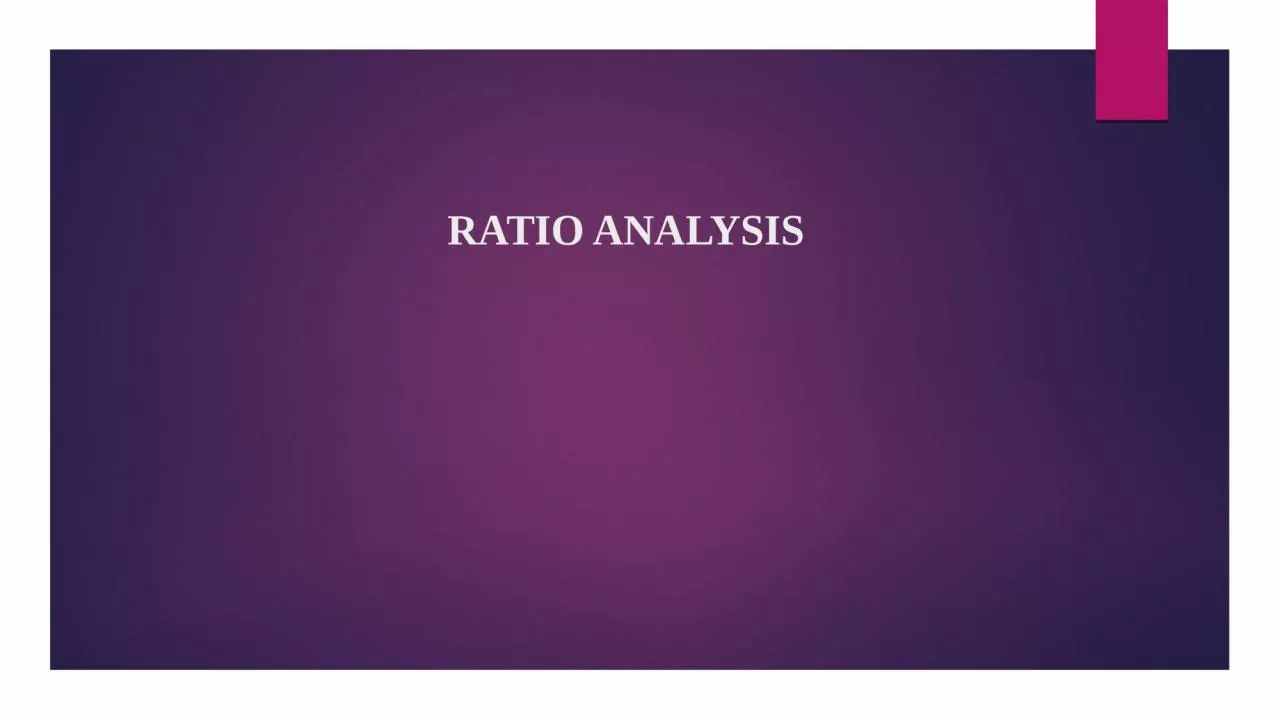

Meaning use and limitations of ratios as a tool of financial analysis Classification of accounting ratios Liquidity solvency and profitability analysis Efficiency activity and leverage ratios ID: 1030145
Download Presentation The PPT/PDF document "RATIO ANALYSIS CHAPTER OBJECTIVES" is the property of its rightful owner. Permission is granted to download and print the materials on this web site for personal, non-commercial use only, and to display it on your personal computer provided you do not modify the materials and that you retain all copyright notices contained in the materials. By downloading content from our website, you accept the terms of this agreement.
1. RATIO ANALYSIS
2. CHAPTER OBJECTIVESMeaning, use and limitations of ratios as a tool of financial analysisClassification of accounting ratios Liquidity, solvency and profitability analysisEfficiency , activity and leverage ratiosMarket test ratiosCalculation of various ratios
3. Meaning of RatioA ratio is a simple arithmetical expression of the relationship of one number to another. It may be defined as the indicated quotient of two mathematical expressions. A financial ratio is the relationship between two accounting figures expressed mathematically. The ratio of two figures 200 and 100 may be expressed in any of the following ways :(a) 2 : 1 (b) 2 (c) 2/1 (d) 2 to 1 (e) 200%
4. Objectives of Ratio AnalysisTo analyse and assess the liquidity position of the firm. To analyse the solvency and leverage of the firm. To assess the earning capacity or profitability of the firm. To provide information for decision making and control. To provide information for making projections and estimates for the future. To provide information for making inter firm comparison and comparison with the industry standards, benchmarks or rules of thumb. To assess the overall efficiency and managerial effectiveness. To provide information about the potential areas of business of the firm which require particular attention of the management.
5. STEPS INVOLVED IN RATIO ANALYSIS
6. USE of Ratio Analysis
7. ADVANTAGES of Ratio Analysis1.Simplify complex data of financial statements and establish relationship between accounting figures.2.Helpful in decision making.3.Helpful in identifying problem areas.4.Tool of comparative analysis.5.Helpful in financial forecasting and planning.6.Helpful in communicating more useful information.7.Helpful in assessing efficacy of management.8.Helpful in effective control of the business.9.Provides information to creditors/bankers etc. for grating credit.10.Useful to shareholders, investors as well as employees.
8. FUNCTIONAL CLASSIFICATION OF RATIOS
9. CLASSIFICATION OF RATIOSLiquidity Ratios. These are the ratios which measure the short-term solvency or financial position of a firm. These ratios are calculated to comment upon the short-term paying capacity of a concern or the firm’s ability to meet its current obligations. Solvency and Leverage Ratios. Long-term solvency ratios convey a firm’s ability to meet the interest costs and repayments schedules of its long-term obligations.Activity Ratios. Activity ratios are calculated to measure the efficiency with which the resources of a firm have been employed. These ratios are also called turnover ratios because they indicate the speed with which assets are being turned over into sales.Profitability Ratios. These ratios measure the results of business operations or overall performance and effectiveness of the firm.
10. Limitations of Ratio Analysis 1.Limited use of a single ratio.2.Lack of adequate standards.3.Inherent limitations of accounting.4.Change of accounting procedure.5.Window dressing.6.Personal bias.7.Incomparable.8.Absolute figures distortive.9.Price level changes.10.Ratios no substitutes.